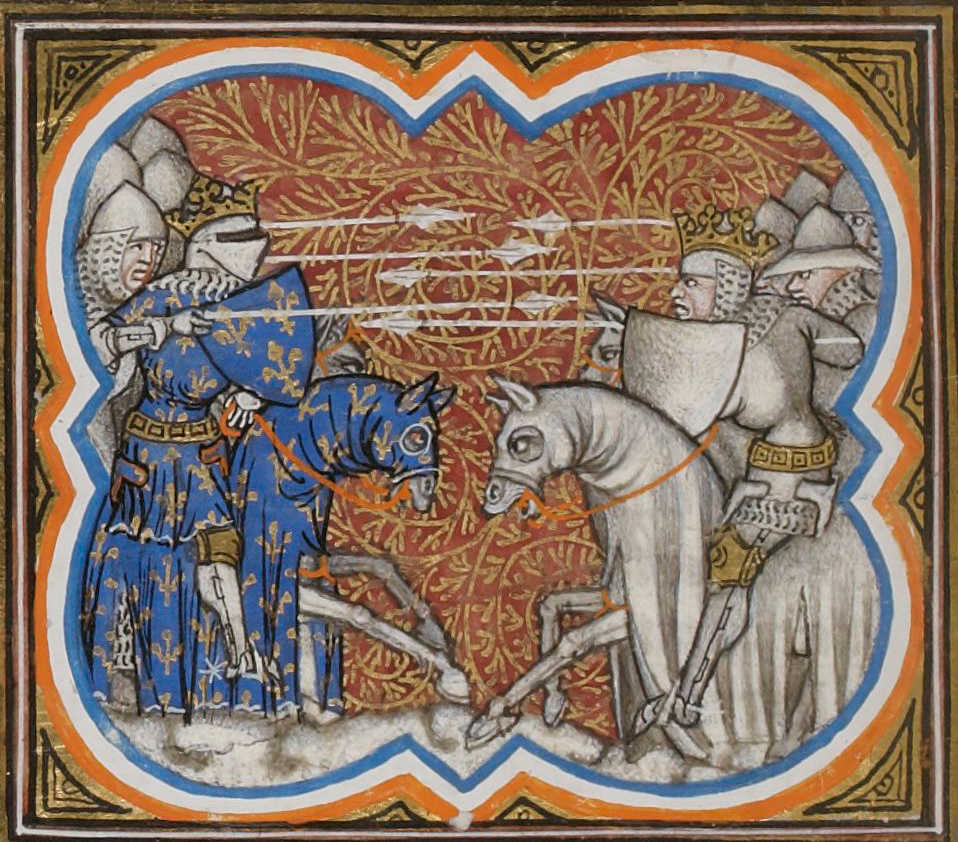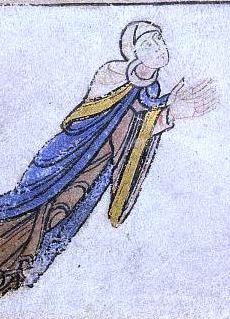 |
| Matilda of Canossa (R) Henry V (C) |
That Matilda
won the trust of her husband over the course of their marriage was made clear
as he made her Regent in his absence on a number of occasions. In April 1115 Archbishop
Frederick excommunicated Henry V and Henry felt the need to deal with matters
in Rome and arrange for his wife’s coronation. He was aided by being made the
heir of Matilda of Tuscany, Countess of Canossa, a great landowner in northern Italy. Matilda of Tuscany had been one of
Pope Paschal’s greatest supporters. This legacy would now enable Henry V to
pressurise on the pope.
Henry left Augsburg in February 1116, his 14 year old wife at his side. Matilda and her
ladies travelled with the imperial army across the Brenner Pass. The imperial couple were welcomed to the Doge’s palace in Venice where they stayed a scant 48 hours.
They then travelled to Padua and Mantua before arriving at Canossa. It took Henry V a year to impose his rule on
the Emilia-Romagna and Tuscany before moving on Rome. Unable to stomach facing down the
imperial troops Paschal retired to Montecassino and Henry V took control of Rome.
There were
no cardinals left in the city to crown Henry and his wife and he was forced to
turn to the French Archbishop of Braga, Maurice Bourdin[i]. The imperial crown was placed on
Matilda’s head at Pentecost 1117. But this was no crowning of
the Holy Roman Emperor; Bourdin had been excommunicated for abandoning
Paschal’s cause. Henry was forced in 1118 to return to Germany uncrowned. He
left his sixteen year old wife to rule his Italian territories. She did not
return to Germany until autumn 1119.
 |
| The battle of Bremule |
In late 1119
an event occurred off the coast of Bar fleur that was to be extremely important for Matilda’s future, and
that of England. A few months earlier, at the battle of Brémule Henry I’s army had soundly defeated Louis and William
Clito. And by the summer Louis was ready to accede to Henry’s demands, agreeing
to accept William Adelin’s homage for Normandy, implicitly recognising Henry’s
right to rule.
That barrier
out of the way Henry and his nobles gathered at Bar fleur where the English
fleet waited to carry the army back to England. The fleet was ready to sail by
25th November; although late in the year for cross-channel trips,
the water was smooth and glassy. The decision was taken to make the crossing
late in the afternoon. Henry sailed on the Seneca while William Adelin sailed
on the White Ship, a brand-new ship of the latest design captained by one Thomas FitzStephen.
 |
| The sinking of the White Ship |
The ship’s
crew and passengers had all been drinking heavily by the time the ship cast
off. FitzStephen was ordered to overtake the king’s ship which had already set
sail. The White Ship was overcrowded and shortly before sailing had numbered
over 300 on board[ii].
The ship hit a submerged rock and sank.
William
Adelin was decanted into a small boat and would have survived had he not turned
back to rescue his half-sister Matilda Fitzroy. This fraternal impulse was
deadly and both William Adelin and Matilda Fitzroy died[iii] as William of Malmesbury
recounts;
‘The oars, too, dashing,
horribly crashed against the rock, and her battered prow hung immoveably fixed.
Now, too, the water washed some of the crew overboard, and, entering the
chinks, drowned others; when the boat having been launched, the young prince was
received into it, and might certainly have been saved by reaching the shore,
had not his illegitimate sister, the countess of Perche, now struggling with
death in the larger vessel, implored her brother’s assistance; shrieking out
that he should not abandon her so barbarously. Touched with pity, he ordered
the boat to return to the ship, that he might rescue his sister; and thus the
unhappy youth met his death through excess of affection: for the skiff,
overcharged by the multitudes who leaped into her, sank, and buried all
indiscriminately in the deep.’[iv]
Henry was
now left with the issue of finding an heir; his eventual choice would tear
England apart. In 1121 Henry remarried and had hopes that his new wife Adeliza, daughter of Godfrey Count of Louvain, would provide England with a new heir, after all Henry had proved his
paternity time and again.
Coming Home
 |
| Henry V (centre) |
Matilda was
eighteen when her brother died, a brother she had not seen for ten years, so it
is possible that she was not too upset. Matilda had hoped to visit her father’s
court in 1122, but Charles I, the Count of Flanders, a vassal of the French king, failed to give a promise of
safe passage. Thereafter Henry V was too busy wresting control of Utrecht from Bishop Godbald to worry about the potential rewards of closer relations with his
father-in-law.
Matilda had
become used to living at the pinnacle of European power; she had even acted as
Regent in her husband’s absences. Matilda and Henry remained childless, but
neither party was considered to be infertile and contemporary chroniclers
blamed their situation on the Emperor and his sins against the Church.
In early
1122, the couple travelled down the Rhine together as Henry continued to suppress the ongoing
political unrest, but by now he was suffering from cancer. In September 1122,
Henry and, probably, Matilda were at the Council
of Worms. The
council settled the long-running
dispute with the
Church when Henry gave up his rights to invest bishops with their episcopal
regalia.
At the age of only 38 Henry V died on 23rd
May 1125. He was buried at Speyer Cathedral, the last of his line and, having handed over the imperial
regalia to the Archbishop of Mainz, the 24 year old Matilda returned to
her father’s court in Normandy. Henry
‘Sent men of distinction and
called his daughter home.’[v]
Matilda
brought home many treasures including the mummified hand of the apostle St James[vi] and two solid gold
coronation crowns. She left behind the lands in Germany that Henry V had
endowed her with. In England Matilda was referred to by courtiers and,
allegedly, her father himself as Imperatrix
augusta[vii].
She was to insist on being so-called for the remainder of her life.
The Oath of Succession
 |
| Queen Adeliza |
On 1st
January 1127, with Roger[viii] Bishop of Salisbury acting as master of ceremonies, the leading,
bishops, lords and abbots of England agreed to honour Matilda as Henry’s
successor. Henry’s marriage to Adeliza had failed to produce any children and
Henry was reduced to the option of making Matilda his heir. William of
Malmesbury reported that Henry;
‘In the twenty-seventh year
of his reign….at the ensuing Christmas, convening a great number of the clergy
and nobility at London….he now at this council compelled all the nobility of
England, as well as the bishops and abbats, to make oath, that, if he should
die without male issue, they would, without delay or hesitation, accept his
daughter Matilda, the late empress, as their sovereign.’[ix]
The most
senior of the laity swearing the oath was King David of Scotland; among the
other nobility was Stephen, son of Henry’s sister Adela. Many of those taking the oath were to find ways of justifying
breaking this solemn vow and the wedding that took place the following year was
used as justification by many that sided against Matilda in the civil strife to
come.
To add to
the general unsettling in Europe, March 1127 saw the brutal murder of the Count
of Flanders, as he prayed before the altar in St Donatien’s cathedral in Bruges. In his place King Louis
installed William Clito, Henry’s greatest enemy. Flanders was an excellent
departure point for any invasion of England, raising the stakes on both sides
of the split. William Clito was also allied with Fulk of Anjou who had fallen
out with Henry over the return of his daughter’s dowry after the sinking of the
White Ship.
Bibliography
The Feudal
Kingdom of England 1042-1216 – Frank Barlow, Pearson Education Ltd 1999
Stephen and
Matilda – Jim Bradbury, The History Press 2005
She Wolves –
Helen Castor, Faber and Faber 2010
Early
Medieval England – MT Clanchy, Folio Society 1997
Henry I – C
Warren Hollister, Yale University Press, 2003
The
Plantagenets – Dan Jones, William Collins 2013
King Stephen
– Edmund King, Yale University Press 2010
Doomsday to
Magna Carta – AL Poole, Oxford University Press 1987
At the Edge
of the World – Simon Schama, BBC 2002
Early
Medieval England – Christopher Tyerman, Stackpole Books 1996
[ii]
A number of the passengers had disembarked due to the drunkenness aboard
[v]
King Stephen - King
[vi]
There are two St James who were considered apostles and there is no evidence to
identify which of the two the hand ‘belonged’
to.
[vii]
Although Matilda was never crowned Empress and documents referring to her in
Germany style her only as Romanorum regina
quite a feat subduing Emilia-Romagna, the Romagnola peasantry are namely for stubborn obstreperousness
ReplyDelete